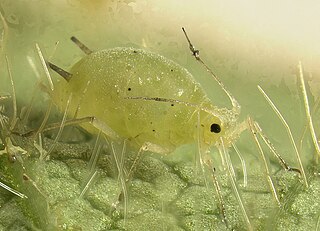
Aphids are small sap-sucking insects and members of the superfamily Aphidoidea. Common names include greenfly and blackfly, although individuals within a species can vary widely in color. The group includes the fluffy white woolly aphids. A typical life cycle involves flightless females giving living birth to female nymphs—who may also be already pregnant, an adaptation scientists call telescopic development—without the involvement of males. Maturing rapidly, females breed profusely so that the number of these insects multiplies quickly. Winged females may develop later in the season, allowing the insects to colonize new plants. In temperate regions, a phase of sexual reproduction occurs in the autumn, with the insects often overwintering as eggs.

The Aphididae are a very large insect family in the aphid superfamily (Aphidoidea), of the order Hemiptera. Several thousand species are placed in this family, many of which are well known for being serious plant pests. They are also the family of insects containing most plant virus vectors with the green peach aphid being one of the most prevalent and indiscriminate carriers.
Citrus tristeza virus (CTV) is a viral species of the genus Closterovirus that causes the most economically damaging disease to its namesake plant genus, Citrus. The disease has led to the death of millions of Citrus trees all over the world and has rendered millions of others useless for production. Farmers in Brazil and other South American countries gave it the name "tristeza", meaning sadness in Portuguese and Spanish, referring to the devastation produced by the disease in the 1930s. The virus is transmitted most efficiently by the brown citrus aphid.

Toxoptera citricida is a species of aphid known by the common names brown citrus aphid, black citrus aphid, and oriental citrus aphid. It is a pest of citrus and vector for the pathogenic plant virus citrus tristeza virus. The aphid spread the virus through citrus groves in Brazil and Venezuela in the 1970s, leading to the near destruction of the citrus industry there. This aphid was first discovered in Florida in 1995.

Aphis is a genus of insects in the family Aphididae containing at least 600 species of aphids. It includes many notorious agricultural pests, such as the soybean aphid Aphis glycines. Many species of Aphis, such as A. coreopsidis and A. fabae, are myrmecophiles, forming close associations with ants.

Myzus persicae, known as the green peach aphid, greenfly, or the peach-potato aphid, is a small green aphid. It is the most significant aphid pest of peach trees, causing decreased growth, shrivelling of the leaves and the death of various tissues. It is also acts as a vector for the transport of plant viruses such as cucumber mosaic virus (CMV), potato virus Y (PVY) and tobacco etch virus (TEV). Potato virus Y and potato leafroll virus can be passed to members of the nightshade/potato family (Solanaceae), and various mosaic viruses to many other food crops.

Cyrtophora citricola, also known as the tropical tent-web spider, is an orb-weaver spider in the family Araneidae. It is found in Asia, Africa, Australia, Costa Rica, Hispaniola, Colombia, and Southern Europe. In 2000, it was discovered in Florida.

Pseudagrion citricola is a species of damselfly in the family Coenagrionidae. It is commonly known as the yellow-faced sprite.

Phylloxeridae is a small family of plant-parasitic hemipterans closely related to aphids with only 75 described species. This group comprises two subfamilies and 11 genera with one that is fossil. The genus type is Phylloxera. The Phylloxeridae species are usually called Phylloxerans or Phylloxerids.
Aphis spiraecola is a species of aphid described in 1914 by Edith Marion Patch. Its common names include green citrus aphid, Spirea aphid, and apple aphid. It is distributed worldwide, and is most abundant in the United States. It has a diploid chromosome number of 2n=8.
The Small Green Rose Aphid, or Strawberry aphid,, also known as Chaetosiphon (Pentatrichopus) tetrarhodum, is an aphid in the superfamily Aphidoidea in the order Hemiptera. It is a true bug and sucks sap from plants.
The rusty plum aphid is an aphid in the superfamily Aphidoidea in the order Hemiptera. It is a true bug and sucks sap from plants.

The Ornate Aphid, or Violet aphid,, is an aphid in the superfamily Aphidoidea in the order Hemiptera. It is a true bug and sucks sap from plants. It is an invasive species.

Pentalonia nigronervosa is an aphid in the superfamily Aphidoidea in the order Hemiptera. It is a true bug and sucks sap mainly from Musa species.

The English Grain Aphid is an aphid in the superfamily Aphidoidea in the order Hemiptera. It is a true bug and sucks sap from plants. It lives on grasses, sedge and rushes and can be a significant pest of cereals.
The Indian Grain Aphid, also known as Sitobion (Sitobion) miscanthi, is an aphid in the superfamily Aphidoidea in the order Hemiptera. It is a true bug and sucks sap from cereal plants, making it a pest of wheat production. A high-quality draft of the S. miscanthi genome 377.19 Mb in size was sequenced to help promote research on the lifestyle and feeding specificity of aphids and their interactions with each other and species at other trophic levels.
The Crapemyrtle Aphid,, also known as Sarucallis (Tinocallis) kahawaluokalani, is an aphid in the superfamily Aphidoidea in the order Hemiptera. It is a true bug and sucks sap from plants. It is most invasive aphids known from Crape myrtle. They were first discovered from Hawaii.
The Sugarcane Woolly Aphid,, is an aphid in the superfamily Aphidoidea in the order Hemiptera. It is a true bug and sucks sap from plants. It is a foliage sucking aphid species.
The Bamboo Woolly Aphid,, is an aphid in the superfamily Aphidoidea in the order Hemiptera. It is a true bug and sucks sap from plants.









